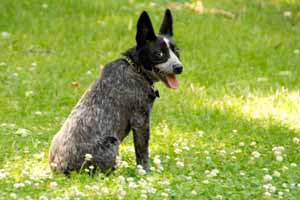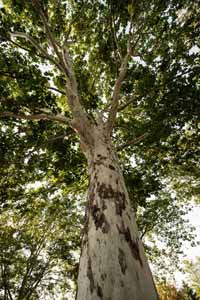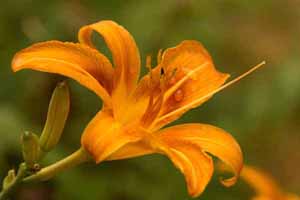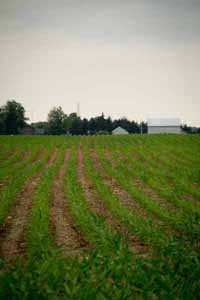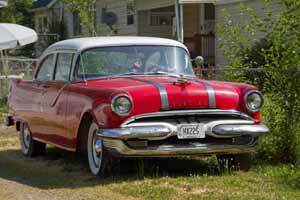Online Magazine
Recent Posts
- Safeguard your Cellphone Photos
- Black & White to Color – Instantly
- Wearing Many Hats
- Video Roundup
- Rescuing Your Blurry Pictures
- Showing Their Age
- What is Your Angle?
- Panorama Photos
- Humorous Photos
- Close Ups
- Fisheye Pictures
- Photo Antiquities
- Printing Big
- Appreciating Scale
- Celebrity Sightings
Tags
More Places to Go
- Free "How-To" Books “How To” books for popular cameras 0
- Vist Us on Facebook keep in touch with us on Facebook 2
Archives
- July 2023 (1)
- March 2023 (2)
- February 2023 (1)
- December 2022 (1)
- October 2022 (1)
- September 2022 (8)
- August 2022 (9)
- July 2022 (1)
- June 2022 (1)
- June 2021 (1)
- May 2021 (1)
- March 2021 (5)
- February 2021 (4)
- January 2021 (2)
- April 2019 (1)
- March 2019 (1)
- February 2019 (1)
- October 2018 (2)
- April 2018 (1)
- March 2018 (4)
- February 2018 (1)
- November 2017 (1)
- August 2017 (1)
- June 2017 (1)
- April 2017 (1)
- March 2017 (5)
- February 2017 (2)
- January 2017 (1)
- October 2016 (1)
- September 2016 (1)
- August 2016 (1)
- July 2016 (1)
- May 2016 (1)
- April 2016 (1)
- March 2016 (2)
- February 2016 (1)
- January 2016 (2)
- December 2015 (1)
- November 2015 (1)
- October 2015 (3)
- April 2015 (1)
- March 2015 (5)
- February 2015 (1)
- January 2015 (4)
- December 2014 (2)
- November 2014 (5)
- October 2014 (2)
- September 2014 (1)
- August 2014 (2)
- July 2014 (1)
- May 2014 (1)
- April 2014 (5)
- March 2014 (5)
- December 2013 (2)
- November 2013 (18)
- October 2013 (1)
- September 2013 (1)
- August 2013 (1)
- July 2013 (1)
- June 2013 (3)
- May 2013 (1)
- April 2013 (2)
- March 2013 (1)
- February 2013 (1)
- January 2013 (1)
- December 2012 (1)
- November 2012 (2)
- October 2012 (2)
- September 2012 (5)
- August 2012 (2)
- July 2012 (1)
- June 2012 (1)
- May 2012 (1)
- April 2012 (4)
- March 2012 (1)
- February 2012 (1)
- January 2012 (3)
- December 2011 (1)
- November 2011 (3)
- October 2011 (1)
- September 2011 (2)
- August 2011 (2)
- June 2011 (3)
- May 2011 (4)
- April 2011 (8)
- March 2011 (8)
- February 2011 (10)
- January 2011 (6)
- December 2010 (11)
- November 2010 (14)
- October 2010 (6)
- September 2010 (12)
- August 2010 (2)
- July 2010 (4)
- June 2010 (3)
- May 2010 (1)
- April 2010 (1)
- March 2010 (2)
- February 2010 (1)
- January 2010 (1)
- December 2009 (1)
- November 2009 (2)
- October 2009 (2)
- September 2009 (1)
- August 2009 (3)
- July 2009 (2)
- June 2009 (1)
- May 2009 (2)
- April 2009 (1)
- March 2009 (2)
- February 2009 (1)
- January 2009 (3)
A Performance Heavyweight
08th August 2012
in an attractive lightweight package
I’ve been a technology buff for a long time.
During the golden age of film, I was introduced to a slew of new camera technology – autoexposure, flash synch, t-mount lenses, autowinders, autofocus. Innovations such as these incrementally improved the technical craft of photography. And then along comes the digital age bringing this photographer a constant stream of remarkable imaging devices with an amazing array of features.
Since the mid 1990’s I’ve owned a countless number of digital cameras. Each year the image quality improved so much that I felt compelled to upgrade to the latest and greatest. Today, I have three or four high quality DLSR cameras and dozens of lenses of various brands. But similar to my political leanings, I’m an independent. I vote for a “candidate” based on the performance that a particular piece of equipment can bring to the task at hand whether his party be Canon, Nikon or Sony.
Although I already have a sizable stable of equipment, I’ve been following the development of a class known as mirrorless interchangeable lens cameras (MILC). My interest in the MILCs centers around their size. At half the size of a typical DSLR, an MILC is also very lightweight. The interchangeable lenses also share this compact advantage. For the past year, I’ve been examining the pros and cons of the various MILCs.
Last week I decided to wait no longer. I acquired the Sony NEX 5, an attractive silver model weighing just 10 ounces compared to the 22 ounce Sony Alpha 57 DSLR which has similar features. The size difference is significant too: NEX 5 is 4-1/2″ x 2-1/2″ x 2″ (width/height/depth) while the Alpha 57 is 5-1/4″ x 4″ x 3-1/4″ (width/height/depth).
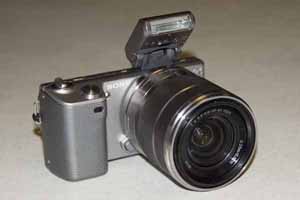 This is the NEX 5, the middle of the road model in Sony’s series of MILCs. |
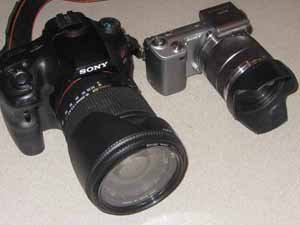 |
All of the cameras in the NEX series have relatively large sensors. They are APS-C size meaning they are the same size as the sensor in many of the high quality DSLRs. This accounts for the high quality of NEX images. To accompany their compact size, the NEX uses Sony’s E-series lenses which are considerably smaller than Sony’s A-series lenses for their DSLRs.
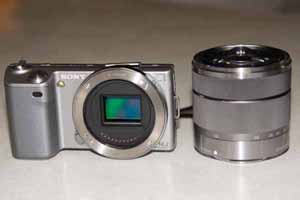 The large APS-C sensor give the NEX series the ability to capture very high quality images. |
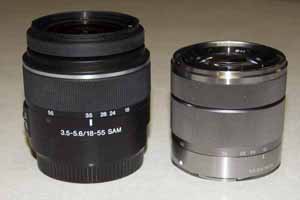 On the left is a traditional DSLR lens compared to a MILC lens for the NEX series. |
Of course the proof is in the images. Here are a few of the first pictures that I took with the NEX 5.
 |
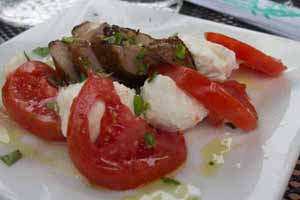 |
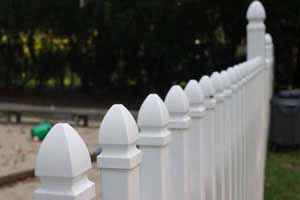 |
 |
Having had the camera for less than a week, I’ve not used all of its features. However, our arsenal includes a Sony A65 DLSR so I am familiar with features such as sweep panorama (combining multiple images to build a wide or tall photograph), DRO (dynamic range optimization to maintain highlight and shadow detail) , HDR (high dynamic range to combine multiple exposures controlling contrast), anti-motion blur (combines 6 separate images) and full 1080 HD video. The NEX series share almost the same features as Sony’s DLSR Alpha series cameras.
So in coming days, I’ll be using the NEX 5 to see how the “lightweight” attempts to produce quality images that are usually reserved for the DLSR crowd. I’m glad that I took the plunge and picked up the NEX 5, an eminently convenient camera in an amazingly small package.
Written by Arnie Lee
What Happens in Vegas . . .
28th July 2012
. . . in the Summer – HEAT
Two weeks ago I learned through Facebook that my close friend was in Las Vegas. Suddenly, I felt the urge to fly out to join him. After all, I hadn’t seen him for several months and I thought the time was right. So the next day, I caught an expensive flight out (last minute flights are always expensive) and we met up by dinner time.
Now keep in mind that when I left my home in Grand Rapids, the scorching heat took temperatures to an amazing 104 degrees. I thought that the Grand Rapids experience prepared me for the Vegas heat. NOT. As it turns out, the temperature in LV reached a record breaking 115.

On my third day in Vegas, while my friend was entrenched in the WSOP tournament, I decided to escape the sizzle by heading northeast to Utah. My destination was Bryce Canyon. At 8,000 ft, the temperature was a much more bearable 80 degrees so hiking into the canyon was in my plans.
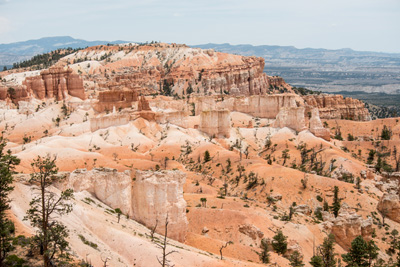 |
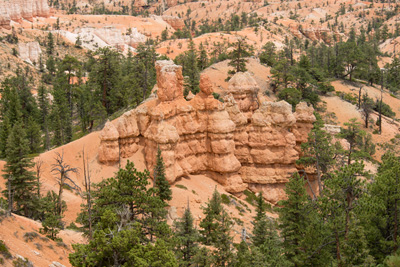 |
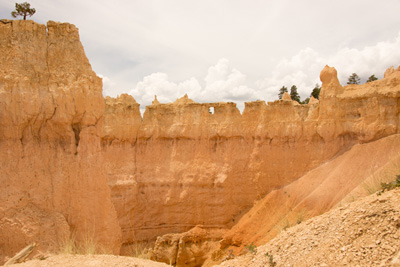 |
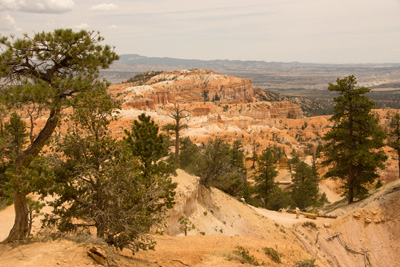 |
My visit to Bryce Canyon National Park was a short four hours.
On the way back to Vegas, I decided to drive through scenic Zion National Park where I caught a slight bit of rain but gorgeous colors.
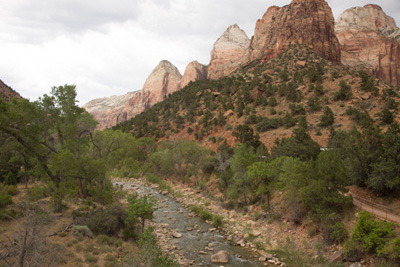 |
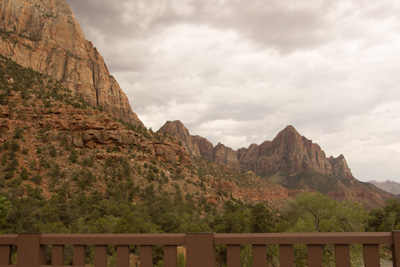 |
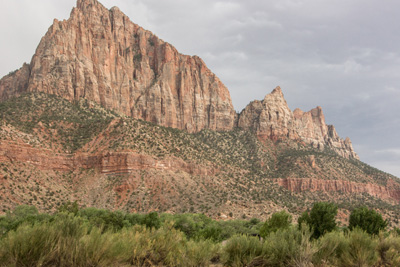 |
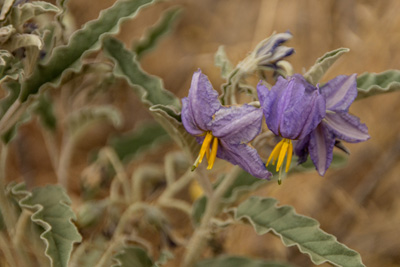 |
So a few hundred miles of driving got me out of the record breaking Las Vegas heat and to some of Utah’s fabulous scenic areas.
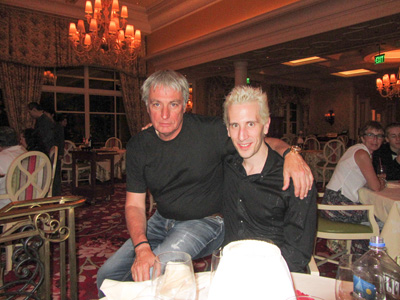
Here we are at dinner: my friend Philippe Olivier and Bertrand “Elky” Grospellier, one of the world’s top poker players. |
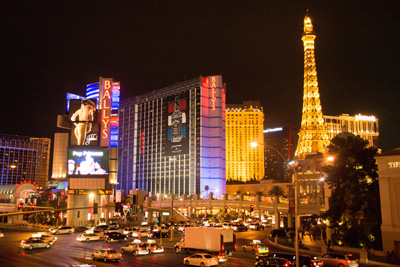
The steamy hot nightlife along the Strip |
In spite of the heat, I had a great visit with my friend Philippe as well as a nice jaunt up to Utah to revisit two of the nicest National Parks. It just goes to demonstrate that there is life outside of Las Vegas.
Written by Arnie Lee
Shooting for Myself vs Shooting for Others
29th June 2012
Simply put, my picturetaking falls into one of two categories: photos taken for “others” and photos taken for personal use.
Photos that I take for others are usually jobs in which the style of the photos is dictated by the needs and desires of the client. These may be a paying client or a freebie client such as a daughter’s birthday party or a sister’s passport photo. She may need a business head shot or he may want an illustrative photo of his industrial machine. A group may want me to photograph an evening event, a restaurant desires closeups of prepared dishes for its new menu or a school a recording of the championship basketball game. Regardless of whether it is a paying or a free transaction, the client generally has a lot of input as to how the completed photos will serve the end goal.
On the other hand, when I take photos for personal use I’m the client. I am free to shoot however, whereever and whatever I like. And as you might expect, this is where I feel the greatest freedom.
While it’s exciting to go on a special outing dedicated to photography, it’s not often that I can squeeze the time into my somewhat hectic schedule. But by keeping a camera nearby, I make it a habit of looking for quick opportunities to sneak in a picture of two.
I get a lot of pleasure photographing “everyday” things such as kids, pets, garden and the like. These are subjects that are close by so I don’t have to make special arrangements to shoot them.
I’ll leave you with this reminder: When you’re the client, you have the freedom to shoot whenever and whatever you’d like. Don’t fall into the “no time today” trap. Nor should you believe that the camera is only for special occasions. With a little preparation (i.e. keeping your camera close by), you can surely find a few everyday subjects to photograph.
Written by: Arnie Lee
« Older Posts — Newer Posts »



